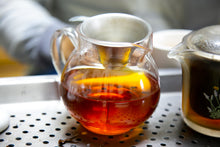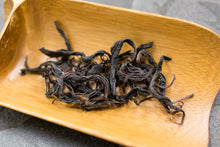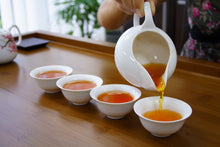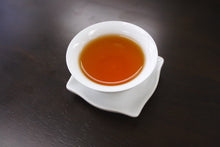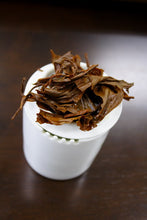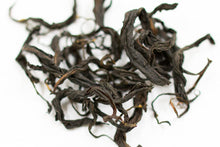
In Chinese, Formosa Black Tea is called Red Jade, or sometimes it is recognized as Ruby Tea.
In Taiwan and China, Jade is one of the most sought after precious stones. In particular, the red jade is a very rare kind. It was given such a name in respect to its highly prized characteristics. Its aroma reminds us of Brandy, especially cognac. Sometimes people associate its aroma to cinnamon or mint with notes of malt sugar. But it seems that most customers rather feel it tastes like brandy. This tea is suitable to go with dessert or drinking it in the evening or night. The strong aroma is enriching and gives a feeling of satisfaction and well-being.
When I mentioned about Taiwanese black tea, many customers seem uninterested and say, "Hmm, Taiwan also has black tea?"
I myself had a preconceived notion that Taiwanese tea means oolong tea, and when I was first introduced to black tea, it didn't come to my mind.
Taiwan has the famous Oriental Beauty.
Oriental Beauty is classified as a oolong tea, but the degree of fermentation is very high, and in fact it is a black tea rather than oolong tea. In short, even in Taiwan, we are familiar with tea with a high degree of fermentation like Oriental Beauty, and those know-hows are firmly reflected in the production of Formosa black tea.
Formosa black tea looks common, but those who drink it will be amazed at its strong characteristic. Its unique flavor is not replaceable. Those who drank it described its unique cup characteristic: a cognac-like scent and a strong mint scent. It is often said that Ceylon tea's, Uva Quality Season Tea has a mint scent, but the mint scent of Formosa black tea is just more than that. It's so strong that it may be more appropriate to call it a brandy-like flavor rather than a mint.
Because it has a strong flavor, you can enjoy it even if you add milk.
However, if you want to enjoy the unique flavor of this tea, you should definitely drink it straight.
History and other knowledge
In Taiwan, when under Japanese ruling, black tea was produced to earn foreign currency and it was exported to overseas in large volume. At that time, Japanese experts actively bred and improved varieties for black tea production, and the technology for black tea production was also established.
Until now, Taiwanese tea has not been very famous. The reason for this was that the production volume was extremely limited, and it was not possible to meet even domestic demand, let alone export to overseas. For that reason, Taiwanese black tea is hardly known overseas, but what is the level of quality?
Among Taiwanese black teas, the one that stands out in terms of quality is Formosa black tea. This tea was created by further improving the Assam varieties that have been cultivated for a long time.
The production area is lowland and the temperature is around 23 ℃ throughout the year. Harvesting begins in spring and the best quality season is summer. Plucking is done by picking one bud and a few leaves. The process itself is not much different from other black teas: Plucking → Indoor withering → Rolling → Fermentation → Drying)
We conducted a survey in Taiwan in search of the highest quality black tea. By visiting the site and exploring, we found a Formosa black tea that has both a refreshing sweet scent as if it contains mint and a mellow and sweet taste. Of course, the tea leaves are from pesticide-free tea gardens.

Tea plucking of Formosa Black Tea
Recommended Brewing Method
Water
In you are using tap water, it is necessary to use a water filter that consists of activated carbon filter. Otherwise, you wouldn't be able to enjoy the authentic taste of tea. If using commercial mineral water, it is important to choose the natural mineral water. Never use distilled water or reversed osmosis processed water. These water lack of mineral content and thus the taste of tea is too soft and a little plain. Soft water is better than hard water. Brewing tea with hard water makes taste bitter while soft water makes taste gentle and sweet. The softness of water is written on the mineral water bottle as TDS: total dissolved solid. You need to choose the water that TDS is below 200mg/liter.
Brewing Temperature
Use boiling water. It is very important to boil water so as to evaporate chlorine and other kinds of contaminated substance in water. Do not boil for more than a few minutes. Boiling too long would rather concentrate the minerals and the character of water may change to hard water.
Brewing Time
The suitable teapot for black tea is the red clay teapot. The bone China ware also gives a good effect. But still the effect of red clay is far beyond bone china. Make sure rinse the tea pot with boiling water for about 10-20 seconds in order to warm it up. Brewing time is about 30 seconds. For 2nd brewing, please keeps the brewing time less than a few seconds.
Quantity of Tea Leaf
Volume of water / 5 = Weight of tea leaf to be used.
Cool down tea leaf
Once brewing is completed, make sure to pour out the tea until the last drop. In addition, please leave the lid opened while waiting for the next brewing. This is important to maintain the taste of subsequent brewing and also to avoid tea leaves from being over cooked.
Step 1

Take 3g of tea leaves (about 1 tablespoon) for 150ml of water.
Step 2

Rinse the teapot with boiling water in order to warm up the teapot. This is a very essential step to keep up the high temperature for brewing.
Step 3

Quickly pour the tea leaves into the tea pot. It is very important to minimize the handling time so as not to cool down the teapot.
Step 4

Brew for 30 seconds to 1 minute
Step 5

When tea is ready, pour it into a pitcher. Keep the distance between the tea pot and pitcher as close as possible to minimize the evaporation of aroma. In cold environment, this will also keep the tea at the higher temperature so that it will be just nice to sip when it is served in a tea cup.
Step 6

Serve tea starting from the right side of tea cup. The last cup is meant for the host. You may observe the golden ring at the edge of tea.

It has an amber-color with a sweet mint flavor

If you drink it in a glass, you can observe the beauty and transparency of the tea, which will increase the enjoyment of drinking.

This is a photo of tea leaves placed in a tea inspection cup. The good quality tea leaves give a strong scent even after brewing tea. Tea leaves reveal more about the quality of tea more than tea liquor.
Storage of Tea
Deeply fermented tea like Formosa black tea lasts for more than 1 year from the day when the bag of tea is opened. Tea is very stable during storage. From the medical point of view, it is safe to consume the tea even if it is kept for a few years. However the freshness disappears if it is kept for too long. Tea must be tightly sealed before it is kept. Tea should be kept in ambient and dry conditions such as in the living room, but it must be completely away from humidity. Tea should not be kept in the kitchen as the environment is very humid. Avoid enclosed area such as inside the cupboard or drawer as these places are damp. Also avoid opening the bag of tea in humid atmosphere. It is recommended to open the bag during a sunny day or under air-conditioned atmosphere. Once tea leaves absorb moisture, deterioration of tea will be triggered within a few days. Tea will then give an astringent taste, sometime it tastes sour. The fresh aroma also becomes weaker.
Beware of keeping the tea in the fridge
The quality of tea lasts longer if it is kept in the fridge. However we strongly recommend you not to keep tea in the fridge. When tea is withdrawn from the fridge, there is usually condensation. Once tea is exposed to moisture during condensation, the quality will deteriorate within a few days. The higher moisture content in the tea leaves will trigger oxidation and it will completely destroy the quality of tea.
Here is another frequently asked question: What happens if bag is sealed using tape or tea is packed in a zipper bag and kept inside the fridge?
For your information, these simple sealing methods are not sufficient. When the bag is withdrawn from the fridge, it is cold inside the bag and therefore causes negative pressure. Air will be drawn from outside and condensation will occur. In addition, if the bag is taken in and out from the fridge very often, this will cause heat stress to the tea leaves as temperature is increased and decreased very frequently. If tea is kept in the fridge, when it is withdrawn from the fridge, it is necessary to leave it in ambient atmosphere for more than 24 hours in order to warm up the tea leaves. Based on our experience, 12 hours is not long enough. We may think tea is warmed up, but inside the bag, the tea leaves are still cold due to insulation effect.
Enjoy Maturation
You can also enjoy the changes of taste and aroma of tea caused by the maturation. When the tea is stored in ambient atmosphere for a few years, tea gets matured and changes its character. Tea loses its refreshing aroma like flowery scent or fresh fruity note; instead, it gives more matured and sweet aroma. It is hard to conclude which is better between the fresh and matured tea. It is depend on individual preference. In general, elderly people prefer a more matured taste of tea.







